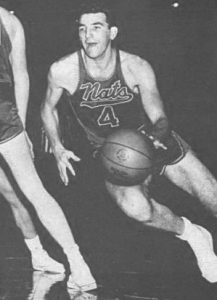Superstars come in many shapes and sizes. They are big, small, smart, stupid, arrogant, and some of them are even insane. The one thing they have always had in common, however, is their ability to make us turn on our TVs and forget about everything except for what they show. They teach us how to win, how to lose, and sometimes even how to live. They are all entertaining, all talented, but only an elite few of them have ever achieved the level of greatness unique to the class of NBA legends. Superstars are made of many different fabrics, but legends are of one strain: ruthless, unrelenting, and absolutely and utterly dominant. Superstars are entertaining, but in the words of Babe Ruth’s ghost in Sandlot, legends never die.
Every once in a while, amidst the scorers and rebounders, there comes a superstar of a completely different strain altogether, a player who transcends the very idea of an athlete, who becomes a showman and an artist. They teach us that basketball is not a sport but an art, not a game but a show, and sometimes they even teach us that selflessness can win championships too. If this column is to be an honest account of the league’s greatest legends, the select few that can call themselves true greats, I cannot sensibly begin any other way other than to honor the very first true NBA legend: the great Bob Cousy. The very first point guard to turn passing into an art form, there’s a reason the Cooz coined the nickname “the Houdini of the Hardwood.” In the era of Steve Nash, Chris Paul, and Rajon Rondo, the name ‘Bob Cousy’ is slowly fading into oblivion. Even as we replay Kyrie Irving’s ankle-breaker on Brandon Knight or Joe Johnson’s crossover around Paul Pierce again and again on Youtube, we forget the father of the modern point guard, the first to dance the tango of the ball-handler.
The Cooz’s dominance in his era was almost unparalleled in basketball history. In terms of legacy, if Bird and Magic saved the NBA, Cousy was the only reason there ever was anything to save in the first place. In an era where players like Bill Russell and Wilt Chamberlain, though unquestionably talented, were never fully appreciated because of their race, Cousy became the reason fans showed up to watch basketball. To say Cousy revolutionized the game would be an understatement. He introduced a whole new strain of basketball to the world, one that turned basketball into an art form instead of a back-and-forth display of muscle, and one that made selflessness and passing a form of domination for the first time.
Along the way, he revitalized the fan culture of the NBA, and he kept the NBA alive even as it struggled to find its identity in the Civil Rights era. When basketball fans came to the Garden, they did not want to watch a game; they came because they expected a show. Whirling up and down the court, throwing the ball behind his back to a teammate no one in the stadium saw until he received the pass, Cousy was the first to make fans “ooh” and “ahh.” He was the very first NBA superstar, and certainly the predecessor of legendary point guards to come. Leading the NBA in assists for eight consecutive years while also finishing in the top ten in scoring for most of his career, to say Cousy was the best point guard in the NBA in his time would be doing the other point guards in the league a huge service. The truth was, most of them didn’t even belong in the same league with Cousy. With six championships and thirteen all-star game appearances under his belt, the only blemish on the Cooz’s revolutionary career was his poor shooting percentage, a figure that goes from poor to good when taken in context of his era. Cousy’s impact on the game of basketball can be compared to Pele’s on the game of soccer. He didn’t just revolutionize the game, he introduced a whole new one that emphasized selflessness and beauty instead of muscle and scoring.
Today, the point guard represents a unique and iconic role in the sports world. The point guard is the navigator, the Commander in Chief. He is the general who leads his team through victory and defeat with poise. He is selfless, he is unflinching, and often, he is the heart and mind of his team. The point guard represents this figure today because of Bob Cousy, because of his success and his incredible talents which changed the sports world forever. Sometimes in sports, we forget about the legacies of different players, and sometimes it’s even important to forget some things, but the legacy of the Houdini of Hardwood is one that we cannot afford to forget.






God this is some great writing. Well done good sir.